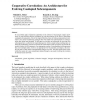Free Online Productivity Tools
i2Speak
i2Symbol
i2OCR
iTex2Img
iWeb2Print
iWeb2Shot
i2Type
iPdf2Split
iPdf2Merge
i2Bopomofo
i2Arabic
i2Style
i2Image
i2PDF
iLatex2Rtf
Sci2ools
EC
2000
2000
Cooperative Coevolution: An Architecture for Evolving Coadapted Subcomponents
To successfully apply evolutionary algorithms to the solution of increasingly complex problems, we must develop effective techniques for evolving solutions in the form of interacting coadapted subcomponents. One of the major difficulties comes in finding computational extensions to our current evolutionary paradigms that will enable such subcomponents to "emerge" rather than being hand designed. In this paper we describe an architecture for evolving such subcomponents as a collection of cooperating species. Given a simple string-matching task, we show that evolutionary pressure to increase the overall fitness of the ecosystem can provide the needed stimulus for the emergence of an appropriate number of interdependent subcomponents that cover multiple niches, evolve to an appropriate level of generality, and adapt as the number and roles of their fellow subcomponents change over time. We then explore these issues within the context of a more complicated domain through a case ...
| Added | 18 Dec 2010 |
| Updated | 18 Dec 2010 |
| Type | Journal |
| Year | 2000 |
| Where | EC |
| Authors | Mitchell A. Potter, Kenneth A. De Jong |
Comments (0)

